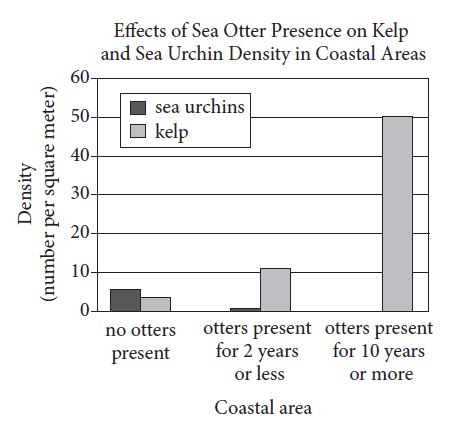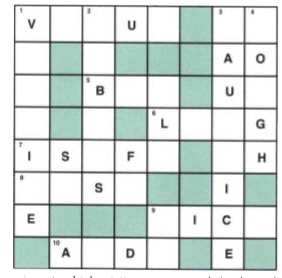
AcrossDown4.Green pigment in leaf1.Tiny pores present on leaf6.Male part of the flower 2.Preparation of food in plants8.Area of the stem where leaves arise 3.Transfer of pollen grains9.Stalk of a flower5.Shoot part of a baby plant 10.Fusion of gametes7.Arrangement of veins in the leaf
AcrossDown4.Chlorophyll1.Stomata6.Stamen 2.Photosynthesis8.Node 3.Pollination9.Pedicel5.Plumule 10.Fertilization7.Venation
Topper's Solved these Questions
- BOOK - PEARSON IIT JEE FOUNDATIONCHAPTER - Plants- Natures Wonderful Food FactoriesEXERCISE - Test 158videos
Plants- Natures Wonderful Food Factories
- BOOK - PEARSON IIT JEE FOUNDATIONCHAPTER - MOVEMENT-AN AMAZING ACTIVITYEXERCISE - ASSESSMENT TEST (TEST 1 (CROSSWORD))1videos
MOVEMENT-AN AMAZING ACTIVITY
- BOOK - PEARSON IIT JEE FOUNDATIONCHAPTER - PLANTS-NATURE'S WONDERFUL FOOD FACTORIESEXERCISE - CROSSWORD1videos
PLANTS-NATURE'S WONDERFUL FOOD FACTORIES
Similar Questions
Calculate data of 6 observations with mean as 10.

AcrossDown2. Information in numerical form1. Data can be represented in pictures.5.360∘times the ratio of copponent value and the sum of values of all components3. In pie chart, the value of component is proportional to this6. Circle is divided like these to represent a data4. Thses are the parts of a kind of a graph8. Angle of all sectors together7. Data represented as a line10. In bar graph the value of the data is proportional to this9. In bar graph all bars are equal in this11. Circular graphIn this graph, data is converted into rectanglesView Solution
AcrossDown2.The process of coating of thin layer of zine on iron1.The full form of LPG6.The full form of CNG3.Lime water is the solution of 7.The inactive component of air4.Greenhouse gas9.The process of coating of thin layer of tin on iron5.The gas essential for photosynthesis10.Air is considered as6.The green pigment required for photosynthesis is12.The process of burning of a substance in the prence of air8.The slow conversion of iron into its hydrated oxide is 13.With increase in height the percentage of oxygen in air______.10.Carbon dioxide turns lime water11.The gas essential for combustionView Solution
Knowledge Check
- Question 1 - Select One
Which of the following statements about sexual reproduction in flowering plants are correct ?
1. Stamen is present in the centre of a flower.
2. Stamen produces pollen grains in the ovary.
3. The swollen bottom part of carpel is the ovary.
4. The fusion of green cells gives rise to zygote.
Select the correct answer using the code given below.A2, 3 and 4 onlyB2 and 4 onlyC1 and 3 onlyD1,2, 3 and 4 only - Question 2 - Select One
Which of the following statements about sexual reproduction in flowering plants are correct ?
1. Stamen is present in the centre of a flower.
2. Stamen produces pollen grains in the ovary.
3. The swollen bottom part of carpel is the ovary.
4. The fusion of germ cells gives rise to zygote.
Select the correct answer using the code given below.A2, 3 and 4 onlyB2 and 4 onlyC1 and 3 onlyD1, 2, 3 and 4 only - Question 3 - Select One
Environmentalist Otters
It has long been known that the sea otters (23) living along the West Coast of North America help––––––––––––––––––––––––––––––––––––––––––––––––––––––– keep kelp forests in their habitat healthy and vital. They do this by feeding on sea urchins and other herbivorous invertebrates that graze voraciously on kelp. With sea otters to keep the population of sea urchins in check, kelp forests can flourish. In fact, (24) two years or less of sea otters can completely eliminate sea urchins––––––––––––––––––––––––––––––––––––––––––––––––––––––––––––––––––––––– in a coastal area (see chart).

Adapted from David O. Duggins, “Kelp Beds and Sea Otters: An Experimental Approach.” ©1980 by the Ecological Society of America.
Without sea otters present, (25) nevertheless–––––––––––––, kelp forests run the danger of becoming barren stretches of coastal wasteland known as urchin barrens.
[1] What was less well-known, until recently at least, was how this relationship among sea otters, sea urchins, and kelp forests might help fight global warming. [2] The amount of carbon dioxide in the atmosphere has increased 40 percent (26) . [3] A recent study by two professors at the University of California, Santa Cruz, Chris Wilmers and James Estes, (27) suggests, that––––––––––––––– kelp forests protected by sea otters can absorb as much as twelve times the amount of carbon dioxide from the atmosphere as those where sea urchins are allowed to (28) devour–––––––– the kelp. [4] Like (29) their––––– terrestrial plant cousins, kelp removes carbon dioxide from the atmosphere, turning it into sugar fuel through photosynthesis, and releases oxygen back into the air.
[5] Scientists knew this but did not recognize (30) how large a role they played–––––––––––––––––––––––––––––– in helping kelp forests to significantly decrease the amount of carbon dioxide in the atmosphere. [6] Far from making no difference to the ecosystem, the presence of otters was found to increase the carbon storage of kelp forests by 4.4 to 8.7 megatons annually, offsetting the amount of carbon dioxide emitted by three million to six million passenger cars each year. (31)
Wilmers and Estes caution, however, that (32) having more otters––––––––––––––––––––– will not automatically solve the problem of higher levels of carbon dioxide in the air. But they suggest that the presence of otters provides a good model of how carbon can be sequestered, (33) or removed, from––––––––––––––––––– the atmosphere through the management of animal populations. If ecologists can better understand what kinds of impacts animals might have on the environment, Wilmers contends, “there might be opportunities for win-win conservation scenarios, whereby animal species are protected or enhanced, and carbon gets sequestered.”ANO CHANGEBsuggests—thatCsuggests, “thatDsuggests that

AcrossDown3. Brain box1. Place where blood cells originate5. Protect spinal cord2. Fibres connecting bones to bones7. Organs to smell in insects4. Breastbone9. Bone in upper arm6. Fibres connecting muscles to bone10. Place where two bones meet8. Thigh boneView Solution
AcrossDown3. Adjustment to habitat1. Plants living in water6. Plant which lives in desert 2. Animals active during night7. Gas released during photosynthesis4. Interaction between biotic and abiotic community8. Organisms which feed on dead animals5. Period between birth and death10. External agent to cause change9. Primary source of energyView Solution
AcrossDown1. Prefix used instead of a 10 power positive number.2. Only these quantities can be measured.6. A body does not change its position.3. Standard reference of a physical quantity.8. The quantity that depends on other quantities.4. Kelvin is the unit of9. Unit of electric current5. Prefix used to represent 10−2 is10. Paper used to measure the area of irregular lamina.7. Distance covered by the body in unit time.View SolutionGiven below is a crossword puzzle. Read the clues across and clues down, and fill up the blank squares.
Clues down
1. Germs or germ - substances introduced into the body to prevent occurrence of an infectious disease.
2. A disease caused by an infected dog that affects the central nervous system.
3. A disease in which the eyes, the skin and the urine turn yellow.
4. The disease pertussis is popularly known as whooping .......
Clues across
1. Category of pathogen that causes diseases like common cold and mumps.
5. This is the vaccine for preventing tuberculosis.
6. An organ usually affected by tuberculosis.
7. Jumbled spelling of one of the most common insect which visits our exposed foods and contaminates them.
8. Cover this part of your body by a handkerchief while sneezing to prevent droplet infection to others.
9. These may readily grow in your hair, if you do not wash it regularly.
10. A disease that weakens body's defence system against infections. View Solution
View Solution
Across
1. An example for metalloid
6. Heaviest element
9. Elements in definite proportion
10. An example for solid non-metal
12. Molecule made up of similar atoms
16. Kerosene and petrol
17. Sublimable substance
18. Property of a material to be drawn into thin wires
19. Conversion of liquid to solid
20. Material used for filtration
Down
2. Groundnut oil and alcohol
3. Conversion of solid to liquid
4. Rotation of mixture at high speed 5. Property of gases
7. Separation of coloured pigments
8. An example for inert gas
11. Properties of metals and non-metals
13. Conversion of gas into liquid
14. Difference in boiling points of liquids
15. Nature of gas in liquid mixturesView Solution

